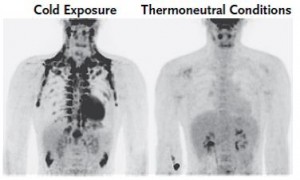Once thought to be the holy grail of energy expenditure manipulators and a potential cure for obesity – fail. I don’t have great evidence for this; it’s really just a hunch.
A new mouse study has provided some additional fodder for speculation, however.
The theory & background info: increased BAT activity can effortlessly burn away excess fat mass by using fuel to create heat instead of energy. This model was most aptly summarized by the title of Dr. Efraim Racker’s 1963 ediorial: “Calories Don’t Count-If You Don’t Use Them.” At best, I don’t think BAT is a panacea. At worst, we might’ve learned our lesson long ago from DNP (circa 1938; also McFee et al., 2004; Miranda et al., 2006; Tewari et al., 2009; and Grundlingh et al., 2011).
In a slurry of publications in 2009, researchers re-ignited the quest by showing cold-induced BAT activation in healthy humans (Virtanen et al., 2009):
Cold exposure, in this case, entailed 2 hours chillin at 64F, then alternating 5 minute bouts of placing one foot into a bucket of ice water (44F) – not wearing an ice pack on their upper back, as advocated by Tim Ferriss in The 4-Hour Body, or taking a cold bath as per Jack Kruse in his Cold Thermogenesis Protocol… although none of these interventions seem particularly comfortable. The authors speculated the cold feet protocol could result in the loss of 9 pounds of fat mass over the course of a year.
Another study tested 2 hours at 61C in light clothing to a similar effect (van Marken Lichtenbelt et al., 2009):
Energy expenditure increased 5-30% upon cold exposure (that’s a lot). They also showed that obese people had impaired BAT activity, although this is not entirely unexpected because they have more normal insulination (ie, adipose tissue), and therefore don’t require as much BAT activation to maintain thermoneutrality.
Nicotine can do this in rats, and even to a greater degree than ephedrine (Baba et al., 2007). At least the former might be more tolerable than cold exposure and/or high dose stimulants. Interestingly, however, 1 mg/kg ephedrine increases metabolic rate (+9%) more so than cold exposure (+5.5%; 2 hours wearing a 57F cold vest) but failed to activate BAT in humans (Cypess et al., 2012) – perhaps due to our relative lack of beta-3 receptors (?); although an earlier study estimated 19.5% of the 22% increase in metabolic rate seen with 1 mg/kg ephedrine could be attributed to BAT (Astrup et al., 1985).
New mouse study: miR-155 kills BAT, and miR-155 KO mice have increased BAT (Chen et al., 2013).
Nomination for figure of the year (Richard Feynman might agree)?
Mice overexpressing mIR-155 (“mIR155TG”), the ones on the bottom, are chilly, suggesting reduced energy expenditure… so these critters should either be obese (they sure don’t look it) or at least not eating nearly as much to maintain normal body weight. Nope:
They have much less BAT, but just as much fat.
What’s more interesting from the human obesity perspective is mice without miR-155, as I’m certain anti-miR155 is already in production for preclinical testing. Indeed, and mice without miR-155 (miR-155-/-) are hot when it’s cold, ie, 39F:
So these guys must be significantly leaner or eating massively to maintain a normal body weight… baaaarely:
Perhaps if they lived in a frosty tundra, miR-155-/- mice would reap the anti-obesity benefits of hyperactive BAT, but not much difference at room temperature. Thus, if we were forced to live in frigid temperatures, naked, anti-miR-155 may keep us warm, but it might not be the cure for obesity living comfortably at room temperature. I suspect that IRL, any effect of increased BAT activity would: 1) make us sweaty; and 2) be easily counterbalanced by increased food intake or reduced physical activity, the latter of which would at least help with all the sweating.
“Calories Don’t Count-If You Don’t Use Them” huh? Perhaps if by “Use,” Dr. Racker meant “Eat.” Otherwise, I’m sticking with: the foods you eat are more important than their caloric content. This is biology, not mathematics.


